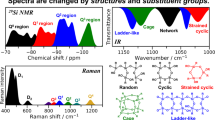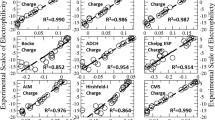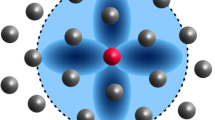Abstract
The atomic-level AI topological indices combined with the Xu topological index were utilized in the quantitative structure–property relationship (QSPR) study of the flash point (FP) temperatures of 92 acyclic alkanes. Modeling of the flash points by the multiple linear regression (MLR) resulted in a three-parameter model consisted of Xu, AI(–CH3) and AI (–CH2–) indices by which the maximum value of the relative percent deviation (RPD) for predicting the FP data was found to be 5.6%. The topological descriptors were subsequently utilized as inputs for an artificial neural network (ANN) to develop a more accurate model. The findings showed that using a 3-5-1 ANN, the RPD values does not exceed 4.0%. The relative importance of the topological indices to the flash points followed the order of AI (–CH3) > Xu > AI (–CH2–) suggesting both atomic groups and molecular bulkiness as the main factors influencing FP values of the studied compounds.












Similar content being viewed by others
Data availability
All data generated or analyzed during this study are included in this published article and its supplementary information files.
References
Crowl DA, Louvar JF. Chemical process safety fundamentals with applications. Pearson Education Inc. 2011.
Isac-Garćıa J, Dobado JA, Calvo-Flores FG, Martínez-Garćıa H, Experimental organic chemistry: laboratory manual. 1st ed. Academic Press; 2015.
Vidal M, Rogers WJ, Holste JC, Mannan MS. A review of estimation methods for flash points and flammability limits. Process Saf Prog. 2004;23:47–55.
Cote AE. Fire protection handbook. 19th ed. National fire protection association. Quincy: MA 2003.
Stauffer E, Dolan JA, Newman R. Fire Debris Analysis. Academic press; 2008.
NFPA30. Flammable and combustible liquids code. National Fire Protection Association. 2003.
Honnet S, Seshadri K, Niemann U, Peters N. A surrogate fuel for kerosene. Proc Combust Inst. 2009;32:485–92.
Katritzky AR, Petrukhin R, Jain R, Karelson M. QSPR analysis of flash points. J Chem Inf Comput Sci. 2001;41:1521–30.
Torabian E, Sobati MA. New methods for predicting the flash point of mixtures containing different alcohols. Process Saf Environ Prot. 2017;111:439–48.
Santos SM, Nascimento DC, Costa MC, Neto AMB, Fregolente LV. Flash point prediction: Reviewing empirical models for hydrocarbons, petroleum fraction, biodiesel, and blends. Fuel. 2020;263: 116375.
Roy K, Kar S, Das RN. A primer on QSAR/QSPR modeling fundamental concepts. Springer International Publishing; 2015.
Roy K. Advances in QSAR modeling: Applications in pharmaceutical, chemical, food, agricultural and environmental sciences. Springer Cham; 2017.
Xiao F, Peng G, Nie Ch, Wu Y, Dai Y. Quantum topological method studies on the thermodynamic properties of polychlorinated phenoxazines. J Mol Struct. 2014;1074:679–86.
Atabati M, Emamalizadeh R. A Quantitative structure property relationship for prediction of flash point of alkanes using molecular connectivity indices. Chinese J Chem Eng. 2013;21:420–6.
Mamy L, Patureau D, Barriuso E, Bedos C, Bessac F, Louchart X, Martin-Laurent F, Miege C, Benoit P. Prediction of the fate of organic compounds in the environment from their Molecular properties: a review. Crit Rev Environ Sci Technol. 2015;45:1277–377.
Kier LB, Hall LH, Frazer JW. An index of electrotopological state for atoms in molecules. J Math Chem. 1991;7:229–41.
Ren B. Novel atom-type AI indices for QSPR studies of alcohols. Comput Chem. 2002;26:223–35.
Wiener H. Structural determination of paraffin boiling points. J Am Chem Soc. 1947;69:17–20.
Balaban AT. Highly discriminating distance-based topological index. Chem Phys Lett. 1982;89:399–404.
Ren B. A new topological index for QSPR of alkanes. J Chem Inf Comput Sci. 1999;39:139–43.
Ren B, Chen G, Xu Y. Estimation of heat capacity of complex organic compounds by a novel topological index. J Chem Eng China. 1999;50:280–6 (in Chinese).
Ren B, Xu Y, Chen G. A novel topological index for QSPR/QSAR study of organic compounds. Acta Chim Sinica. 1999;57:563–71 (in Chinese).
Ren B. Novel atomic-level-based AI topological descriptors: Application to QSPR/QSAR modeling. J Chem Inf Comput Sci. 2002;42:858–68.
Ren B. Application of novel atom-type AI topological indices to QSPR studies of alkanes. Comput Chem. 2002;26:357–69.
Ren B. Application of novel atom-type AI topological indices in the structure-property correlations. J Mol Struct (THEOCHEM). 2002;586:137–48.
Ren B. Atom-type-based AI topological descriptors: application in structure-boiling point correlations of oxo organic compounds. J Chem Inf Comput Sci. 2003;43:1121–31.
Ren B. Atomic-level-based AI topological descriptors for structure−property correlations. J Chem Inf Comput Sci. 2003;43:161–9.
Panneerselvam K, Antony MP, Srinivasan TG, Rao PRV. Estimation of normal boiling points of trialkyl phosphates using retention indices by gas chromatography. Thermochim Acta. 2010;511:107–11.
Safa F, Yekta M. Quantitative structure–property relationship study of standard formation enthalpies of acyclic alkanes using atom-type-based AI topological indices. Arab J Chem. 2017;10:439–47.
Osaghi B, Safa F. QSPR study on the boiling points of aliphatic esters using the atom-type-based AI topological indices. Rev Roum Chim. 2019;64:183–9.
Safa F, Alizadeh Dakhel A, Shariati Sh. Predictive artificial neural network model for solvation enthalpy of organic compounds in N,N-dimethylformamide. Russ J Phys Chem A. 2019;93:2661–8.
Safa F. Atomic-level topological indices for prediction of the infinite dilution activity coefficients of oxo compounds in water. J Sol Chem. 2020;49:222–38.
Safdel F, Safa F. Atom-type-based AI topological indices for artificial neural network modeling of retention indices of monomethylalkanes. J Chromatogr Sci. 2019;57:1–8.
Safa F, Jafari Ghadimi M. Graph theoretical atom-type-based descriptors for structural characterization and retention prediction of acyclic alkanes. Mosc Univ Chem Bull. 2021;76:157–68. https://doi.org/10.1093/chromsci/bmy081.
Safa F, Manouchehri F. Unified linear and nonlinear models for retention prediction of aliphatic aldehydes and ketones in different columns and temperatures: application of atom-type-based AI topological indices. Chem Africa. 2022. https://doi.org/10.1007/s42250-022-00495-1.
Pan Y, Jiang J, Wang Z. Quantitative structure–property relationship studies for predicting flash points of alkanes using group bond contribution method with back-propagation neural network. J Hazard Mater. 2007;147:424–30.
Mathieu D. Inductive modeling of physico-chemical properties: Flash point of alkanes. J Hazard Mater. 2010;179:1161–4.
Mathieu D. Flash points of organosilicon compounds: How data for alkanes combined with custom additive fragments can expedite the development of predictive models. Ind Eng Chem Res. 2012;51:14309–15.
Yi-min D, Hui L, Xiao-Qing C, You-Nian L, Xun L, Zhi-Ping Z, Yue-Fei Z, Zhong C. A new group contribution-based method for estimation of flash point temperature of alkanes. J Cent South Univ. 2015;22:30–6.
Albahri TA, Esmael NAM. SGC based prediction of the flash point temperature of pure compounds. J Loss Prev Process Ind. 2018;54:303–11.
Dean JA. Lange’s Handbook of Chemistry. 15th ed. New York: McGraw-Hill; 1999.
MATLAB R2013a, The Math Works Inc., http://www.mathworks.com
SPSS for Windows, Statistical package for IBM PC, Release 20.0, SPSS Inc., http://www.spss.com.
Marquardt D. An algorithm for least-squares estimation of nonlinear parameters. J Soc Ind Appl Math. 1963;11:431–41.
Andrea TA, Kalayeh H. Applications of neural networks in quantitative structure-activity relationships of dihydrofolate reductase inhibitors. J Med Chem. 1991;34:2824–36.
Aleboyeh A, Kasiri MB, Olya ME, Aleboyeh H. Prediction of azo dye decolorization by UV/H2O2 using artificial neural networks. Dyes Pigm. 2008;77:288–94.
Needham DE, Wei IC, Seybold PG. Molecular modeling of the physical properties of alkanes. J Am Chem Soc. 1988;110:4186–94.
Acknowledgements
The authors are thankful to Armita Safa, M.Sc. student in Bioinformatics at the University of British Columbia for her valuable help in writing the algorithms during the computational stage of the work.
Funding
Not applicable.
Author information
Authors and Affiliations
Contributions
FF contributed to data analyzing and writing the original draft. FS contributed to supervision, project administration, interpretation, writing–review and editing.
Corresponding author
Ethics declarations
Conflict of interest
The authors declare that they have no competing interests.
Ethics approval and consent to participate
Not applicable.
Consent for publication
Not applicable.
Additional information
Publisher's Note
Springer Nature remains neutral with regard to jurisdictional claims in published maps and institutional affiliations.
Supplementary Information
Below is the link to the electronic supplementary material.
Rights and permissions
Springer Nature or its licensor (e.g. a society or other partner) holds exclusive rights to this article under a publishing agreement with the author(s) or other rightsholder(s); author self-archiving of the accepted manuscript version of this article is solely governed by the terms of such publishing agreement and applicable law.
About this article
Cite this article
Fazehi, F., Safa, F. Atomic-level AI topological indices as efficient descriptors for developing predictive QSPR models for flash points of acyclic alkanes. J Therm Anal Calorim 148, 2129–2138 (2023). https://doi.org/10.1007/s10973-022-11859-7
Received:
Accepted:
Published:
Issue Date:
DOI: https://doi.org/10.1007/s10973-022-11859-7




